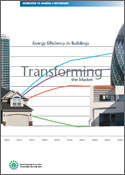Building Sector Must Change to Meet Global Energy Targets
 New modeling by the World Business Council for Sustainable Development (WBCSD) shows how energy use in buildings can be cut by 60 percent by 2050 - essential to meeting global climate change targets - but this will require immediate action to transform the building sector.
New modeling by the World Business Council for Sustainable Development (WBCSD) shows how energy use in buildings can be cut by 60 percent by 2050 - essential to meeting global climate change targets - but this will require immediate action to transform the building sector. This is the central message of the report from the WBCSD’s four-year, $15 million Energy Efficiency in Buildings (EEB) research project, the most rigorous study ever conducted on the subject.
The EEB’s report ’Transforming the Market: Energy Efficiency in Buildings’, its unique simulation model and the project’s roadmap to transform the building sector were presented in Paris at the Alliance to Save Energy’s EE Global Forum and Exposition. The report will also be released in Washington, D.C., and Beijing.
“Energy efficiency is fast becoming one of the defining issues of our times, and buildings are that issue’s ’elephant in the room’. Buildings use more energy than any other sector and as such are a major contributor to climate change,” said Bjorn Stigson, president of the WBCSD.
“Unless there is immediate action, thousands of new buildings will be built without any concern for energy efficiency, and millions of existing, inefficient buildings using more energy than necessary will still be standing in 2050. Acting now means reducing their energy consumption and making real progress in controlling climate change.
“The market alone will not be able to make the necessary changes. Most building owners and occupants don’t know enough and don’t care enough about energy consumption, and inertia is reinforced by assumptions that costs are too high and savings too low. That’s why we are calling for a major, coordinated and global effort. If we can create that, we will cut greenhouse gas emissions and stimulate economic growth at the same time,” he said.
The project took a bottom-up, market-driven approach to understanding the barriers to lower energy use, based on the most detailed view ever of the current state of energy demand in buildings. Energy use by building type was analyzed for millions of existing and new buildings and projected out to 2050, accounting for differences such as climate and building design.
Using computer simulations, researchers were able to show the market response to various combinations of financial, technical, behavioral and policy options, identifying the optimum mix to achieve transformation for each market studied. The project’s resulting report makes six principle recommendations:
- Strengthen building codes and energy labelling for increased transparency.
- Use subsidies and price signals to incentivize energy-efficient investments.
- Encourage integrated design approaches and innovations.
- Develop and use advanced technology to enable energy-saving behaviour.
- Develop workforce capacity for energy saving.
- Mobilize for an energy-aware culture.
Full details of the EEB proposed “transformation roadmap” for the building sector can be found in the report, available in English on the World Business Council for Sustainable Development website http://www.wbcsd.org.
Downloads: - Transforming the Market: Energy Efficiency in Buildings (PDF 5.3 MB): EEB Roadmap (PDF 72 kb):
Source: World Business Council - WBCSD
You can return to the main Market News page, or press the Back button on your browser.

